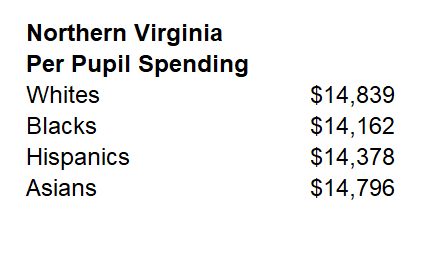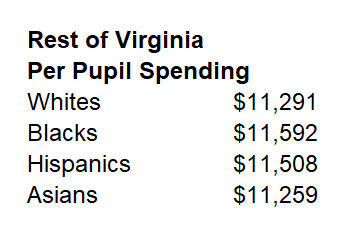by James A. Bacon
The Virginia Board of Education (VBOE) has unanimously adopted a statement regarding its commitment to provide equal access to a high-quality public education.
“Systemic racism and discrimination still exist in public education, and too often, a student’s skin color or socioeconomic status predicts the quality of their educational opportunities,” says the statement. The VBOE goes on to attribute the educational achievement gap between whites and “people of color” to unequal funding.
The current system of funding for our schools, codified as the Standards of Quality, has not resulted in meaningful changes in educational outcomes. In fact, in combined effect with the previously long-standing Standards of Accreditation, segregation in our schools has increased. We have seen resources, in terms of funding and personnel, migrate to schools and localities that disproportionately served fewer students of color. The result has been a recognized achievement gap that continues to persist.
There is one big problem with this statement. There is no meaningful black-white funding gap in Virginia. The VBOE provides no statistics whatsoever to back up its statement. Repetition of a falsehood does not make it true. Here are the average annual per-pupil expenditures for school operations across the state broken down by race/ethnicity:
 From a statewide perspective, there is a funding gap in Virginia, but it’s between Asians and Hispanics on the one hand and blacks and whites on the other. If the BOE had restricted its claim to the existence of a white/black funding gap, not a gap between whites and “people of color,” it would have been on firmer ground, although that gap is barely more than one-tenth of one percent. Good luck trying to explain the educational achievement gap (which is very real) on a one-tenth of one percent difference in spending.
From a statewide perspective, there is a funding gap in Virginia, but it’s between Asians and Hispanics on the one hand and blacks and whites on the other. If the BOE had restricted its claim to the existence of a white/black funding gap, not a gap between whites and “people of color,” it would have been on firmer ground, although that gap is barely more than one-tenth of one percent. Good luck trying to explain the educational achievement gap (which is very real) on a one-tenth of one percent difference in spending.
Where the numbers come from. Here’s how I crunched the numbers. I drew upon Table 13 of the Superintendent’s Annual Report for Disbursements by Division for Fiscal 2019 as well as the enrollment numbers by race provided by the Virginia Department of Education’s Fall Membership Build-A-Table. To reduce the complexity of my presentation, I excluded American Indians, Native Hawaiians and Pacific Islanders, two or more races, and unknowns. For each locality, I applied the per-pupil expenditure for each school district to the number of children of each ethnicity.
For example, Accomack County reported a per-pupil expenditure of $10,819 for Fiscal 2019 and an enrollment of 1,915 black students. Thus, I calculated total expenditures for black students in Accomack by multiplying $10,819 times 1,915 to get $20,719,170. I replicated that calculation for whites, Asians, and Hispanics for each school district in the state.
Adjusting for Northern Virginia. Most of the statewide spending differentials can be explained by the demographics of Northern Virginia localities, which have a higher percentage of Asians and Hispanics than downstate localities. The higher expenditures reflect two main things: (1) a highly educated population in NoVa that places a high priority on K-12 schooling, and (2) the higher cost of living, which requires NoVa localities to pay higher teacher and administrator salaries. Given the differing demographics and cost of living, it makes sense to look at NoVa and RoVa separately.
Here are the downstate numbers.
Outside of Northern Virginia, spending per pupil is distributed remarkably evenly among the races. Insofar as any racial group is favored, it is African Americans at $11,592 per pupil. Insofar as any racial group is disfavored, it is whites at $11,291. The black/white gap is 2.7% — in favor of blacks!
Let me repeat for emphasis, RoVa school districts spend 2.7% more per African-American student than whites. Expenditures for Hispanics and Asians fall between the two.
The situation is a little different in Northern Virginia.
 The gap between whites and Asians is minimal (about three-tenths of a percent), larger between whites and Hispanics (3.2%) and largest between whites and blacks (4.8%).
The gap between whites and Asians is minimal (about three-tenths of a percent), larger between whites and Hispanics (3.2%) and largest between whites and blacks (4.8%).
Insofar as racial disparities in per-pupil funding are caused by “systemic racism and discrimination” in Virginia, it is mostly limited to Northern Virginia, and it is not very large.
However, if we accept the logic that disparities in funding are prima facie proof of “racism and discrimination,” then it appears that the racism and discrimination in RoVa favors blacks and discriminates against whites.
There may be other ways to slice and dice the data, and I’m happy to share my spreadsheet with anyone who wants to see the data for themselves. Contact me at jabacon[@]baconsrebellion.com.
Bacon’s bottom line: The Virginia Board of Education statement that the racial achievement gap in Virginia can be attributed to unequal funding has no factual basis whatsoever. This is leftist dogma which, by virtue of constant repetition, people have come to accept as fact. “Repeat a lie often enough and it becomes the truth,” Nazi propaganda chief Joseph Goebbels famously said. As I recall, he had a few race obsessions of his own.


Leave a Reply
You must be logged in to post a comment.